 Geez, everyone's a damn critic. I mean, look around. I play the blues for a reason. 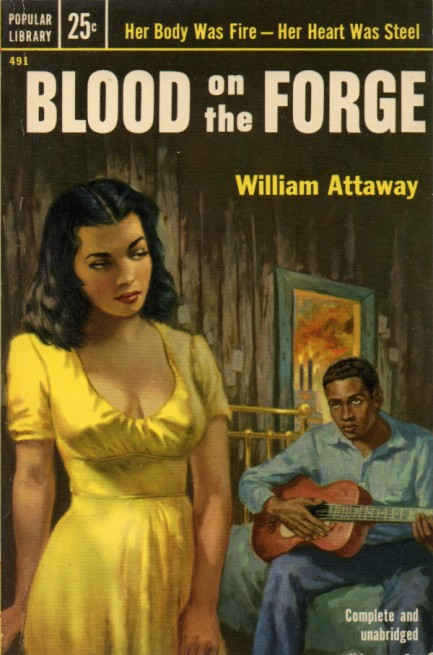 
Chicago based author William Attaway's Blood on the Forge is another of those highly serious literary novels that got the good-girl-art cover treatment. Numerous previously published authors were repackaged in this way during the 1950s. We're talking everyone from George Orwell to Aristarchus of Samos. This Popular Library edition is from the heyday of the makeover era—1953—but the book first appeared in 1941. It's about African American sharecroppers during the early twentieth century leaving their agrarian existence in Kentucky and heading to West Virginia, where they seek better lives and something closer to equality (the rear cover says Pennsylvania, but that happens much later in the story). This era is known historically as the Great Migration, when a lot of blacks got the hell out of the South and the increasingly vicious Jim Crow culture that thrived after slavery. The characters in Blood on the Forge find, like most real life migrants did, that the North is also unfair and difficult.
The cover art isn't as much of a stretch as it often is with these pulped up versions. The guitar player is Melody Moss, a major character, and the woman is Anna, who in the narrative is a Mexican girl of fourteen, but is depicted as well above the age of consent here. It's a pretty nice piece of art, though by an unknown (Ray Johnson? Owen Kampen?). As for the actual fiction, it was neglected for decades but it's now considered a literary classic and Attaway is recognized as an important figure of the Black Chicago Renaissance. Fitting, because Attaway was a real Renaissance man. He stopped writing novels after Blood on the Forge and moved into music and writing screenplays for radio, films, and TV. In 1957 he published the Calypso Song Book, a compendium of tunes he had collected. He also wrote for Harry Belafonte, including the classic "Banana Boat Song (Day O).” By the end of his career he had penned over 500 songs. You have to be impressed.
 Sure, you can get a hot coffee—right in your lap if you don't get your meathooks off me 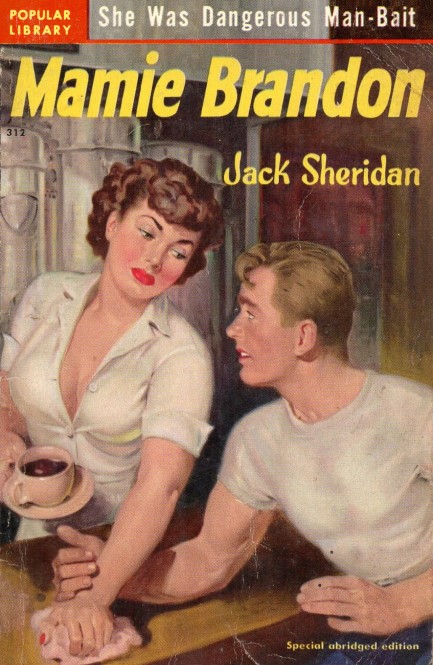
Rudolph Belarski once again shows his unique painterly skill on this cover for Mamie Brandon by Jack Sheridan. The book, which first appeared in 1949 in England, deals with Mamie Thomas, who runs a roadhouse in desolate central California. She becomes Mamie Brandon when she marries an older man for security, but quickly finds when an old flame reappears in town that money doesn't satisfy all her needs. You know the drill—attraction, infidelity, death. This Popular Library edition has two copyrights. The first date is listed as 1950 “by arrangement with the author,” but a second date specifies January, 1951. Since the book is slightly abridged, according to the editors, maybe the two copyrights make sense somehow.
 Tallman takes readers on a wild trip to Mexico. 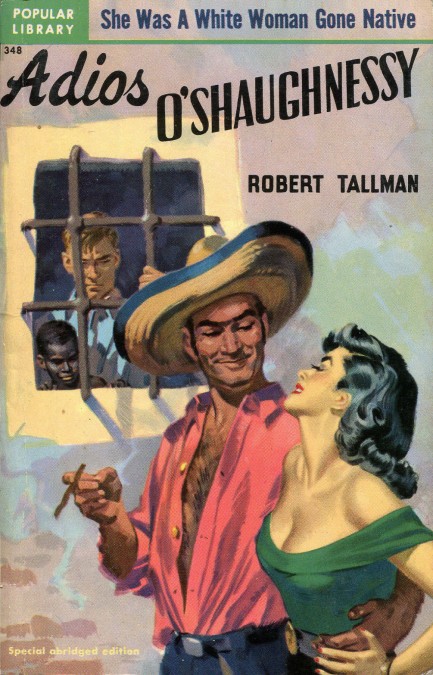
Colorado born writer Robert Tallman achieved his first true recognition from 1947 to 1949 writing the weekly radio program The Adventures of Sam Spade. He went to Acapulco on vacation, ended up staying a year, and that idyll inspired his first novel, 1950's Adios O'Shaughnessy, about a collection of bizarre characters who've fetched up in a fictional Mexican town called Pollo Sabroso. Besides the title character, there's the raven haired beauty Gloria Blackman (described as a blonde in the rear cover blurb either by mistake or for marketing purposes), the young Mexican hunk Manuel Mendoza, and a black child named Miguelito who wanders the town—for reasons we can't discern—naked. It's the precocious Miguelito who provides the title of the book when he notices O'Shaughnessy looks like Robert Donat in Goodbye, Mr. Chips.
The plot of the book is barely discernible, but partly involves a fishing boat and the various characters who covet it. Some want to fish in it, while others have more political aims that ultimately lead to deadly violence. The book worked for us not because of its plot, but because of its depiction of gringos cast adrift in Latin America. Despite the serious subject matter, Tallman's writing is ornate and often lighthearted. For example: “Ramirez, acquainted with the eellike elusiveness of this class of quarry, grabbed him by the most convenient handle, the baggy seat of his pants. There was an ominous sound of ripping fabric, and the disaster resulting was such that the poor witness, in all modesty, could not now walk upon the streets.”
Here's another nifty passage that gives an even better sense of Tallman's style: “Had a goddess leaped forth from the limpid, luminous swells, he would not have been altogether astonished. What did leap forth was much more unlikely. A slim, small-breasted woman with a face like an ecstatic mask, legs as long as a fashion drawing, and with the graceful bather's especial gift of emerging from the water without seeming wet: this is what he saw before he realized it was Ella Praline, stark naked, running  up the beach pursued by a naked boy who resembled a faun in more ways than one.” Pretty cool, that whole sequence, though it ends rather weirdly for poor Ella. up the beach pursued by a naked boy who resembled a faun in more ways than one.” Pretty cool, that whole sequence, though it ends rather weirdly for poor Ella.
In fact the whole novel is weird, and while it takes its time coming together, it eventually reveals itself to be good entertainment for those who don't mind fiction that's more influenced by Graham Greene than by Dashiell Hammett. Also, it spoke to us on a personal level because, like Tallman, we threw caution to the wind and moved abroad—to Guatemala not Mexico. Tallman captures the drinking, the fighting, the skinny dipping, the random stupidity, the constant undercurrent of danger, the earthquakes and volcanic eruptions, the beautiful women who pass through for days or weeks to turn the town upside down, and, most of all, the odd personalities who think all of this is the best possible way to live. We count ourselves among them. Whatever else one thinks of Adios O'Shaughnessy it has the feel of the real thing.
 Okay, I take it back—you don't hit like a girl. 
Above you see a great Sam Peffer cover for Jonathan Latimer's Solomon's Vineyard, originally published in 1941, and banned in the U.S. until 1988. We could go into why it was blacklisted, but as always it doesn't really matter, because save for a brief mention of underage sex the book is not racy by today's standards. Its best quality is not sexual innuendo anyway, but toughness. To give you an example, we'll transcribe one of its many interesting scenes. The main character Karl Craven—a burly ex-football player-turned-private detective—becomes upset at the layered deceptions he's had to deal with and finally loses his temper:
I grabbed her by the arms and shook her. Her false teeth fell out and rolled across the carpet. [snip] I started into the parlour, but a thin man in shirtsleeves was in the way. I hit him and he went down. In the parlour the blonde who'd slugged me with the lamp began to scream. She thought I was coming for her. I went to the big radio in the corner. I picked it up, tearing out the plug, and tossed it across the room. It shattered against the wall. I kicked over a table with two lamps on it. I tore some of the fabric off a davenport. I threw a chair at a big oil painting over the fireplace. I took a metal stand lamp and bent it up like a pretzel. I pulled up the oriental rug and ripped it down the middle. the wall. I kicked over a table with two lamps on it. I tore some of the fabric off a davenport. I threw a chair at a big oil painting over the fireplace. I took a metal stand lamp and bent it up like a pretzel. I pulled up the oriental rug and ripped it down the middle.
That's going berserk like you mean it. We won't bother with a long plot summary since you can find those all over the internet, but basically the protagonist is hired to spring a woman from a cult and finds himself neck deep in corpse worship, hidden treasure, police corruption, and sado-masochism. The book is reasonably well written, very hard boiled, and built around a set of unlikely characters—including a femme fatale known by all as “The Princess.” Great Pan published it in 1961, and it had an alternate cover which you also see here. It was re-issued several times after its debut—including by Popular Library as The Fifth Grave—which means it isn't hard to find. We recommend you give it a read.
 It wasn't me! I swear! You want the goth chick in 4D! 
Rudolph Belarski has some of the most recognizable artistic output of the mid-century period. This is his work on the front of the 1949 Popular Library edition of Elisabeth Sanxay Holding's The Death Wish, which first appeared in hardback in 1935. In the plot, it's actually two men wishing to be free of their marriages that starts all the trouble. The women are potential victims, though not wholly sympathetic ones. Do you wish you could read something convoluted and at times verging on the ridiculous? Congrats—this may be it. Still, it's a good book. Holding's rep as one of the top suspense writers of her period was deserved.
 Tell you what—no-strings-attached sex, plus a twelve pack, and I'll order pizza. Now do you wanna come over? 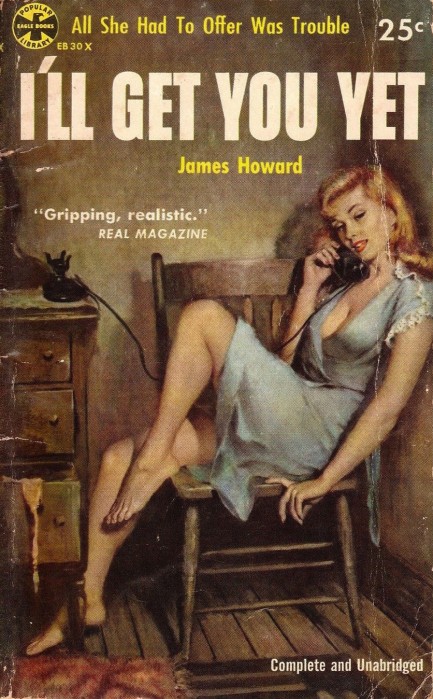 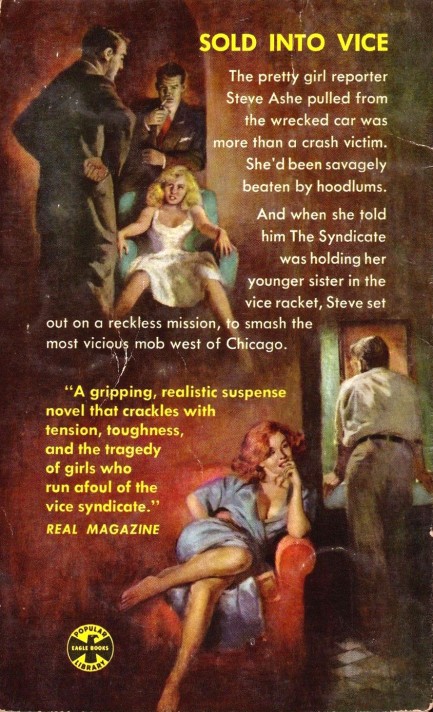
Above, James Howard's I'll Get You Yet, 1954 from Popular Library's sub-imprint Eagle Books, with art by an unknown generally suspected to be Ray Johnson or Owen Kampen. The cover wraps around, and the rear gives you the gist of the plot, which involves a man trying to defend a woman and her sister from organized crime baddies. Regarding the art, we think Johnson is the more likely perpetrator, though we may never have an official answer. But you can see why we're guessing Johnson by taking a look at another of his pieces here. See if you don't agree there's a strong stylistic similarity. Also, this uncredited cover is definitely the same artist. Johnson too? We suspect so.
 A rage to love? Right now I'd welcome a mild interest in cleaning up after yourself. 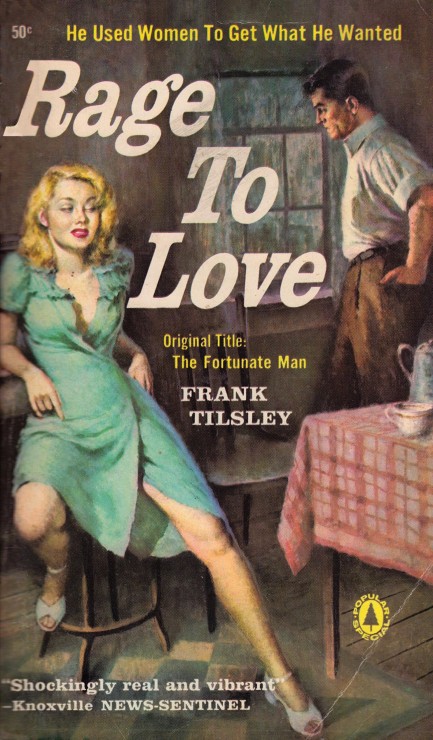
This is a nice piece of uncredited art fronting Frank Tilsley's A Rage Love, his second of numerous novels, this one dealing with a cruel and ambitious man named Jimmy Magnall, who's fresh out of the army in 1919 and eager to pluck the world's plump fruit for his enjoyment, and who uses women in his climb from slummy Birmingham roots to the top of the London class pyramid. He rides high for some years, but of course eventually loses all he has, including the women, and enlists right back in the army at the beginning of World War II. These are especially interesting bookends for the character because the author Tilsley was bothered by having been too young to fight in World War I and too old to enlist for combat in World War II, so engineering Jimmy Magnall into both wars may be a case of living vicariously. The book was originally published in 1953 as The Fortunate Man and was well reviewed in most quarters. We would love to know who painted the cover art, but no such luck. 1959 copyright on this Popular Library edition.
 Hello there, my dear. Guess what today is. 
That look right there. That's the one you never want to see on someone's face, because even if they aren't actually going to kill you, they're for sure thinking about it. In Dana Chambers' Someday I'll Kill You, the heroine Lisa is targeted by a blackmailer who threatens to pin an accidental death on her as murder if she doesn't pony up a hundred grand. She summons help to her enclave in the Connecticut countryside in the form of a rugged pilot and former lover with the unlikely name Jim Steele. He's reluctant to get involved because Lisa jilted him after a Caribbean idyll and married a wealthy psychiatrist. But he can't resist—and really, how can he when asked by “a long-legged, slim-hipped Diana with—startlingly and unforgettably—the breasts of Venus.”? The story unfolds from his perspective—partly obscured by the aforementioned Venusian breasts—as blackmail leads to murder, first thought to be a case of mistaken identity, then understood to be part of the plan. Steele sets about trying to unravel the scheme and to somehow insert himself back into Lisa's bed. Chambers, aka Albert Leffingwell originally published this in hardback in 1939, with the Popular Library paperback edition you see above coming in ’53. There's considerable online debate about who painted the cover art, but for now it remains in the unknown bin.
 Just stay over there a minute. I want you to get the full effect of this awesome pose. 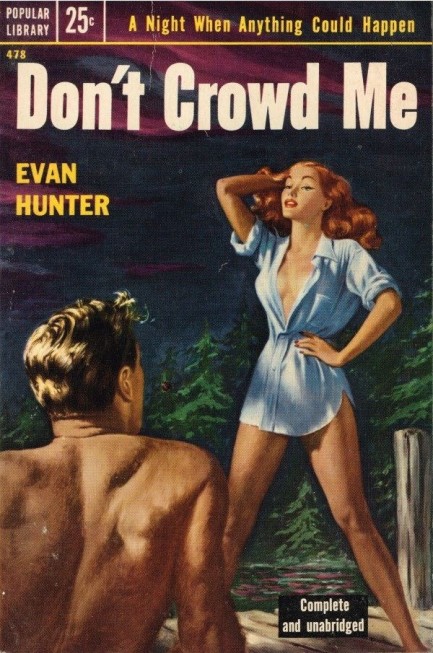
In Evan Hunter's 1954 novel Don't Crowd Me an NYC advertising copywriter seeks tranquility in the lake region but instead finds himself encountering two sisters with very different temperaments who both seem to find him irresistible. Then, of course, there's a murder to spoil everything, and it looks like he's the only one who can solve it. The plot may sound improbable, but Hunter, born Salvatore Albert Lombino, was better known by his pseudonym Ed McBain, which means you would expect this to be decently written. And in fact you would be correct. The cover art, which is great, was painted by Walter Popp.
 The whole town knew—but was what they knew right? 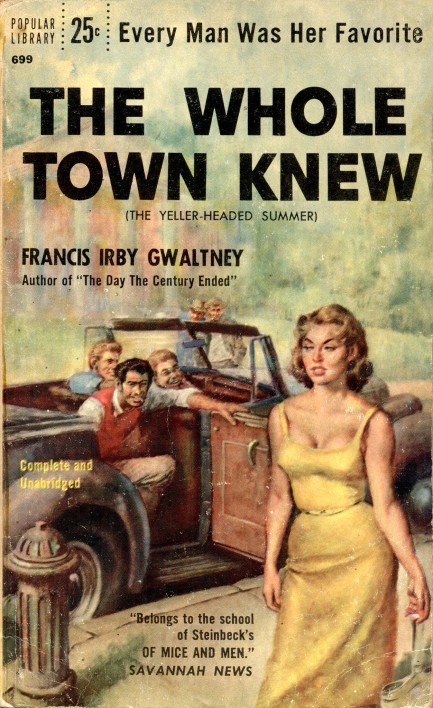
It's amazing how many mid-century authors were compared to Erskine Caldwell, but such was his influence that any pass at southern smalltown loving, feuding, and corruption prompted reviewers to cite him as the king of the genre. Francis Irby Gwaltney's The Whole Town Knew, originally published as The Yeller-Headed Summer, was compared by many to Caldwell. It deals with the rape and murder of a woman, subsequent efforts to find her killer or killers, efforts to keep the details of her free-spirited ways out of court, local newspaper drama, a not-too-bright lawman in way over his head, and more. This lawman is the center of the book, and his problems mount tremendously—starting with the fact that he's supposed to leave influential members of the community alone and stick to policing poor and powerless folk. Art imitates life, right? The town of Walnut Creek was close kin to the burgs from Caldwell's oeuvre, as were the antics of the townspeople, but the book was well reviewed, leading to Irby—actually a protégée of Norman Mailer, whose mentorship was instrumental—becoming very famous for a time. We love the cover art on this 1955 Popular Library edition. It was painted by Ray Johnson, who always does great work, as you can see here and here.
 |  |
|
 |

The headlines that mattered yesteryear.
1926—Aimee Semple McPherson Disappears
In the U.S., Canadian born evangelist Aimee Semple McPherson disappears from Venice Beach, California in the middle of the afternoon. She is initially thought to have drowned, but on June 23, McPherson stumbles out of the desert in Agua Prieta, a Mexican town across the border from Douglas, Arizona, claiming to have been kidnapped, drugged, tortured and held for ransom in a shack by two people named Steve and Mexicali Rose. However, it soon becomes clear that McPherson's tale is fabricated, though to this day the reasons behind it remain unknown. 1964—Mods and Rockers Jailed After Riots
In Britain, scores of youths are jailed following a weekend of violent clashes between gangs of Mods and Rockers in Brighton and other south coast resorts. Mods listened to ska music and The Who, wore suits and rode Italian scooters, while Rockers listened to Elvis and Gene Vincent, and rode motorcycles. These differences triggered the violence. 1974—Police Raid SLA Headquarters
In the U.S., Los Angeles police raid the headquarters of the revolutionary group the Symbionese Liberation Army, resulting in the deaths of six members. The SLA had gained international notoriety by kidnapping nineteen-year old media heiress Patty Hearst from her Berkeley, California apartment, an act which precipitated her participation in an armed bank robbery. 1978—Charlie Chaplin's Missing Body Is Found
Eleven weeks after it was disinterred and stolen from a grave in Corsier near Lausanne, Switzerland, Charlie Chaplin's corpse is found by police. Two men—Roman Wardas, a 24-year-old Pole, and Gantscho Ganev, a 38-year-old Bulgarian—are convicted in December of stealing the coffin and trying to extort £400,000 from the Chaplin family. 1918—U.S. Congress Passes the Sedition Act
In the U.S., Congress passes a set of amendments to the Espionage Act called the Sedition Act, which makes "disloyal, profane, scurrilous, or abusive language" about the United States government, its flag, or its armed forces, as well as language that causes foreigners to view the American government or its institutions with contempt, an imprisonable offense. The Act specifically applies only during times of war, but later is pushed by politicians as a possible peacetime law, specifically to prevent political uprisings in African-American communities. But the Act is never extended and is repealed entirely in 1920.
|

|
|

It's easy. We have an uploader that makes it a snap. Use it to submit your art, text, header, and subhead. Your post can be funny, serious, or anything in between, as long as it's vintage pulp. You'll get a byline and experience the fleeting pride of free authorship. We'll edit your post for typos, but the rest is up to you. Click here to give us your best shot.

|
|







 up the beach pursued by a naked boy who resembled a faun in more ways than one.” Pretty cool, that whole sequence, though it ends rather weirdly for poor Ella.
up the beach pursued by a naked boy who resembled a faun in more ways than one.” Pretty cool, that whole sequence, though it ends rather weirdly for poor Ella.

 the wall. I kicked over a table with two lamps on it. I tore some of the fabric off a davenport. I threw a chair at a big oil painting over the fireplace. I took a metal stand lamp and bent it up like a pretzel. I pulled up the oriental rug and ripped it down the middle.
the wall. I kicked over a table with two lamps on it. I tore some of the fabric off a davenport. I threw a chair at a big oil painting over the fireplace. I took a metal stand lamp and bent it up like a pretzel. I pulled up the oriental rug and ripped it down the middle.


















































































